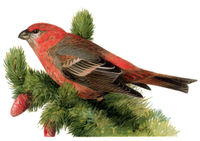|
Pine Grosbeak Conservation status Least concern |
||||||||||||||||
|---|---|---|---|---|---|---|---|---|---|---|---|---|---|---|---|---|

Pine Grosebeak by
Louis Agassiz Fuertes
|
||||||||||||||||
| Scientific classification | ||||||||||||||||
|
||||||||||||||||
| Pinicola enucleator (Linnaeus, 1758) |
The Pine Grosbeak, Pinicola enucleator, is a large finch. It is the only member of its genus and represents an ancient divergence of the ancestors of the bullfinches (Arnaiz-Villena et al., 2001), diverging perhaps a dozen mya during the Clarendonian. Given that the radiation of the bullfinches (which are only found in Eurasia) and the mountain finches (also closely related: Marten & Johnson, 1986) started approximately at the same time in the interior of Asia, it is possible that the Pine Grosbeak evolved in North America; possibly, its ancestors were wind-blown individuals of a proto-bullfinch which arrived via the northern Pacific as at that time the Bering Land Bridge was widely inundated.
Adults have a long forked black tail, black wings with white wing bars and a large bill. Adult males have a rose red head, back and rump. Adult females are olive-yellow on the head and rump and grey on the back and underparts.
Their breeding habitat is coniferous woods across Canada, Alaska and the western mountains of the United States, and in northern Fennoscandia. They nest on a horizontal branch or in a fork of a conifer.
This bird is a permanent resident through most of its range; in the extreme north or when food sources are scarce, they may migrate further south.
This species is a very rare vagrant to western Europe.
These birds forage in trees and bushes. They mainly eat seeds, buds, berries and insects. Outside of the nesting season, they often feed in flocks.
The Pine Grosbeak was depicted on the 1986 series Canadian $1000 note.
References
- Arnaiz-Villena, A.; Guillén, J.; Ruiz-del-Valle, V.; Lowy, E.; Zamora, J.; Varela, P.; Stefani, D. & Allende, L. M. (2001): Phylogeography of crossbills, bullfinches, grosbeaks, and rosefinches. Cellular and Molecular Life Sciences 58: 1159–1166. PDF fulltext
- BirdLife International (2004). Pinicola enucleator. 2006 IUCN Red List of Threatened Species. IUCN 2006. Retrieved on 12 May 2006. Database entry includes justification for why this species is of least concern
- Marten, Jill A. & Johnson, Ned K. (1986): Genetic relationships of North American cardueline finches. Condor 88(4): 409-420. PDF fulltext




 216.73.216.91
216.73.216.91 User Stats:
User Stats:
 Today: 0
Today: 0 Yesterday: 0
Yesterday: 0 This Month: 0
This Month: 0 This Year: 0
This Year: 0 Total Users: 117
Total Users: 117 New Members:
New Members:
 216.73.xxx.xx
216.73.xxx.xx
 Server Time:
Server Time: